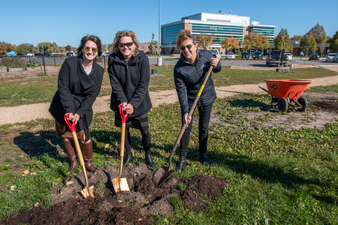 The Metropolitan Airports Commission (MAC) recently marked its 75th anniversary with a tree-planting event.
Collaborating with the local non-profit Tree Trust, several groups of MAC employees participated in the planting of 40 trees earlier this month behind the MAC’s General Offices building on 28th Avenue, near Mother Lake.
|
 The trees included swamp white oaks, honey locusts, river birch, non-fruiting crabapples, Kentucky coffeetree and London plane trees.
The diversity of the trees is meant to protect against any single species becoming susceptible to specific and harmful pests, such as the emerald ash borer.
|
 “These trees are lasting and living reminders of the longevity the MAC has enjoyed over the past seven decades,” said Brian Ryks, the MAC’s CEO and executive director. “They’re a symbol of our ongoing efforts to be a more sustainable organization, and they will also benefit MAC employees and the public for decades to come.”
For the planting event, Tree Trust placed the trees and dug the holes ahead of time, MAC employees planted the trees and back-filled the holes, and the MAC’s Field Maintenance Department provided a water truck and mulch.
More information about Tree Trust is available at its website.
|
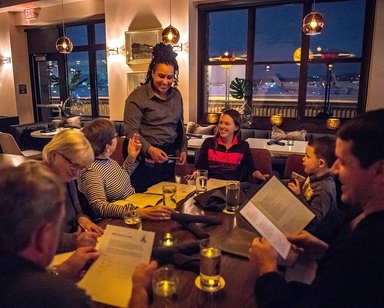 Holman’s Table, the popular restaurant in the St. Paul Downtown Airport’s historic terminal building, is ready for your next big event.
With new event space capable of serving up to 70 people, Holman’s Table is preparing for the holiday season. The event room with broad views of the airfield is available for breakfast, lunch and dinner catered by Holman’s Table, said Chas Enselein, the restaurant’s general manager.
The private space on the west side of the terminal building – opposite the restaurant – has already been the site of groom’s dinners, wedding receptions and business meetings. More information about the event space is available at the Holman’s Table website.
Holman’s Table’s unique location at the airport is also leading to a sense of adventure for patrons, who can now take in a helicopter flight after their meal.
On Friday and Saturday evenings from 4 p.m. until 9 p.m. – and by appointment – scenic helicopter flights are offered just outside the restaurant. The new service offers beautiful views of downtown St. Paul and surrounding areas.
“Holman’s Table is stepping up its offerings, and we’re excited to have more people experiencing the St. Paul Airport,” said Joe Harris, the airport’s manager.
Minnesota Helicopters Inc. offers the flights, which are $50 per person for an 8-minute ride. Longer flights are available for additional fees.
|
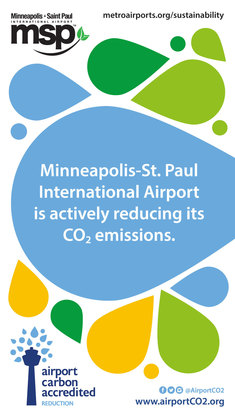 The Airports Council International-North America recently recertified the Metropolitan Airports Commission’s Level 2 status in the Airport Carbon Accreditation Program. The program demonstrates the organization’s ongoing commitment to sustainable operations at Minneapolis-St. Paul International Airport (MSP) and a reduction of its carbon footprint.
Maintaining Level 2 accreditation in the program requires year-over-year reductions in CO2 emissions. A carbon reduction target also is required.
The MAC realized a 13.3 percent reduction in emissions per passenger in 2017 compared to its 2014-15 average baseline. The MAC is on pace to meet its carbon reduction target of 15 percent by 2020.
The Terminal 2 solar project at MSP and other energy efficiency initiatives helped drive lower carbon emissions in 2017. The Terminal 2 solar array involves 3,130 solar panels atop the terminal’s parking ramps.
Coupled with a solar array on top of Terminal 1’s parking ramps that started operating in 2015, MSP Airport has the largest structure-mounted solar array in the state of Minnesota, with a 4.3 megawatt capacity.
Carbon reduction efforts in 2018 included efficiency upgrades to lighting and HVAC units.
|
(Editor’s note: Following is the ninth in a series of articles on the history of the Metropolitan Airports Commission, which is marking its 75th anniversary this year. Earlier stories in the series are found on this website.)
The 2000s brought big changes to Minneapolis-St. Paul International Airport – some slowly after years of planning, some quickly after unforeseen events.
Work on the new Hubert H. Humphrey Terminal (Terminal 2) had started in 1999 as demand for gates grew and the Metropolitan Airports Commission (MAC) worked to make the local market more competitive.
The terminal plans included eight gates and a Customs inspection facility in the initial construction phase and, soon after, two more gates.
The grand opening took place on May 2, 2001, with a Hawaiian band playing and Sun Country Airlines, Champion Air and Omni Air International planes occupying the gates. The new terminal featured common-use gates, ticket counters and baggage carousels providing shared terminal operations, plus capacity for new airlines, both domestic and international.
There were 24 airlines serving MSP in the late 1990s. Sun Country was in the midst of converting itself from a strictly charter airline into a low-cost scheduled airline, and the new Humphrey Terminal aided that expansion.
The former Humphrey Terminal was razed soon after the new one opened, eventually making way for parking ramps with spots for 10,000 cars.
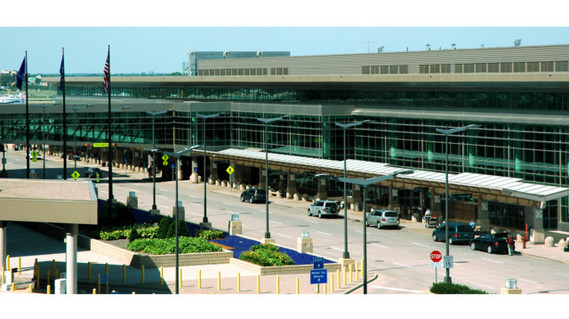 The new Humphrey Terminal, now Terminal 2, opened in May, 2001.
The 9/11 tragedy
Minneapolis-St. Paul International Airport (MSP) was in the midst of a normal Tuesday morning schedule when, at 7:46 a.m. Minneapolis time, American Airlines flight 11 was crashed into the World Trade Center.
The second flight struck the building at 8:03; at 8:37 a.m. flight 77 crashed into the Pentagon and started a fire -- the third hijacked plane to intentionally crash that morning.
U.S. airspace shut down at 8:45 a.m. and all aircraft in flight were ordered to land at the nearest airport as soon as possible.
News of the attacks spread quickly, and buildings considered high profile targets were shut down all around the country. By 8:30 that morning, the Mall of America had put “closed” signs on its doors. At 9:05 a.m., the IDS Center in downtown Minneapolis was evacuated.
The MAC activated its emergency plan; all emergency workers were called in and those already here stayed.
Numerous unscheduled flights arrived at MSP, including two large planes with international passengers.
The ticketing level and mezzanine level of Terminal 1 were full of stranded passengers for much of the day. Airport staff and Northwest Airlines employees worked to provide water, track down hotels with enough space for hundreds of people, and find buses to transport them.
In 2001, few passengers had mobile devices to find another way home, and airport staff and travel agents helped travelers find another way to their destination.
MSP remained closed until Thursday, Sept. 13. Northwest Airlines had planned to restart part of its schedule that day but later delayed all flights until Friday. About 45 planes total took off from MSP that Thursday.
Airports in Boston and Washington D.C. did not re-open Thursday Sept. 13; New York-area airports were briefly open that day but then closed after police arrested a man who tried to get through security with a false pilot’s identification.
Hundreds of parking spaces in the ramps near MSP’s Terminal 1 were off limits after 9/11, as the FAA enforced a rule that unattended cars couldn’t be left within 300 feet of airport terminals. By mid-October, most of the parking spaces were again available.
The airport didn’t run out of parking spaces during the month of restricted parking, as passenger volume dropped sharply after the attacks.
The 9/11 attacks also led to the formation of the Transportation Security Administration, which operates the security checkpoints at airports. Previously, private firms that contracted with airlines or airports had handled passenger screening.
Passenger traffic eventually rebounded at MSP and by 2004 MSP passenger numbers were close to 2000 levels again.
In 2005, MSP recorded its highest annual number ever of passengers, serving 37.6 million – a volume not surpassed until 2017.
Although a deep recession technically started in December 2007, air travel began to slip well before that date as the economy lost momentum. MSP’s passenger numbers declined in 2006 and dipped to 32.3 million in 2009 before starting to rise again.
Construction projects transform MSP
The decision to expand the current airport instead of build a new one somewhere else – decided in the 1990s – led to major building projects throughout the 2000s.
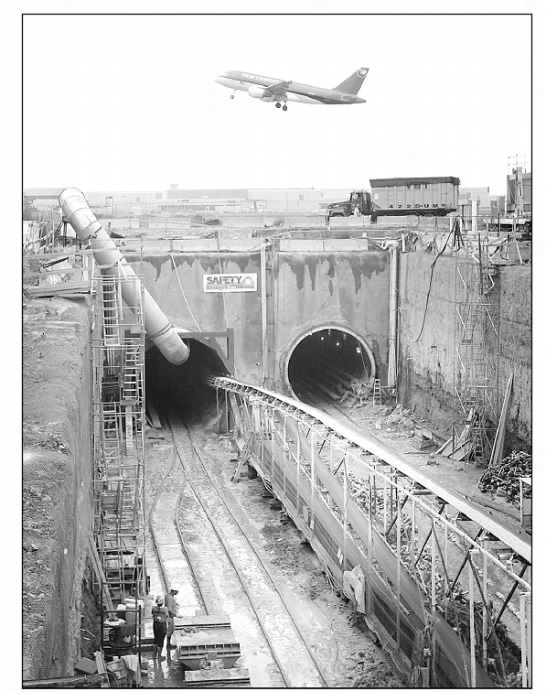 Construction of the Blue Line LRT tunnels underneath MSP's runways in August, 2002.
The construction of runway 17/35 started in the spring of 1999 and necessitated the removal of a half-million truckloads of dirt. Sand and gravel was trucked in, and enough cement was poured to build a sidewalk from Minneapolis to New Orleans.
The runway was initially planned to be open to air traffic in 2003. After travel demand declined and airline revenues slumped following 9/11, the runway work was slowed and the completion date moved to 2005.
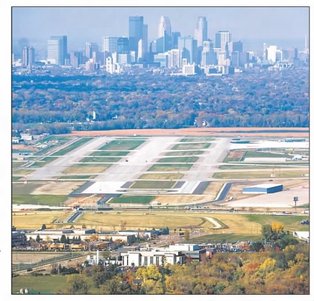 Pictured: The new runway 17/35, shortly after it opened in October 2005.
The runway’s grand opening in October of 2005 featured a 5K race on the new taxiways and runway. The ribbon-cutting ceremony included MAC officials, Doug Steenland, then CEO of Northwest Airlines, and Chris Blum, the regional administrator for the Federal Aviation Administration.
Concourses A and B were also built in the decade, providing gate access to passengers via jet bridges for regional jets – and taking passengers off the tarmac and out of the elements.
New passenger trams opened on Concourse C and underneath Terminal 1’s parking ramps to facilitate fast, efficient service through the terminal.
The ongoing construction of the Blue Line LRT project attracted media attention, as it stretched from downtown Minneapolis, through MSP and south to the Mall of America.
At MSP, a 100-foot long boring machine produced two 7,300-foot long parallel tunnels 20 feet apart under the airfield.
The new LRT line opened in 2004, providing airport employees and passengers another option for transportation to both MSP terminals. Today, Terminal 1’s station has the highest number of boardings of all the Blue Line’s 19 stations.
|
Delta and Northwest combine operations
Airlines’ struggles after the 9/11 tragedy continued, and a spike in oil prices following Hurricane Katrina in late August, 2005, also added to the financial challenges.
Delta Air Lines filed for bankruptcy reorganization in September 2005, after not reporting a profitable quarter since 2000. Less than a half hour later, Northwest Airlines did the same.
At the time, Delta was the nation’s third largest carrier and Northwest was the fourth largest.
Over the next two years, Northwest and Delta cut costs, trimmed payrolls and renegotiated debt with lenders to provide financial stability. Delta also restructured its fleet of airplanes and focused more on international flights.
When the two airlines emerged from bankruptcy in the spring of 2007, it marked the first time in five years that a major U.S. airline wasn’t in bankruptcy proceedings.
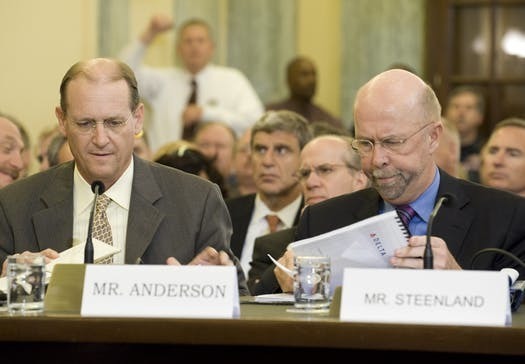 Delta Air Lines' Richard Anderson and Northwest Airlines' Doug Steenland testify before Congress.
After exiting bankruptcy, Delta named Richard Anderson as its new CEO. Anderson had been CEO at Northwest up until 2004, when he left for an executive position with United Healthcare.
In 2008, Anderson and Northwest CEO Doug Steenland began explaining to Wall Street and US lawmakers why the two airlines should be allowed to merge.
On April 15, 2008, the two carriers announced a merger agreement.
Testifying before Congress in May 2008, Anderson told lawmakers that the merger would likely lead to job losses at Northwest’s headquarters in Eagan, Minn. However, he pledged to retain other jobs in Minnesota, including thousands of jobs at MSP Airport and 450 at a reservation center in Chisholm.
The two CEOs also addressed lawmakers’ concerns about less competition, job security, reductions in service and fare increases.
Ultimately, the deal passed an antitrust review by the U.S. Department of Justice, as the two airlines’ routes had minimal overlap. The deal was an acquisition of Northwest by Delta, and the new carrier’s combined headquarters were based in Atlanta.
Over a period of more than a year, the two airlines’ merged their operations, including the repainting of Northwest planes with the Delta livery, consolidation of gates in some airports and, in 2009, the merger of Northwest’s WorldPerks frequent flier program with Delta’s SkyMiles program.
In 2013, Endeavor Air – a regional carrier for Delta that had previously been known as Pinnacle Airlines and had an air service agreement with Northwest – moved its headquarters from Memphis to MSP Airport.
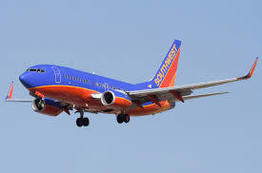 Southwest arrives at MSP
In November of 2008, Southwest Airlines announced that it would start service from MSP to Chicago’s Midway Airport -- where Southwest was serving 47 destinations -- on March 8, 2009.
The announcement was another sign of the MAC’s ongoing and increasingly successful efforts to bring more competition to the Twin Cities’ market.
Southwest’s inaugural flight at MSP’s Terminal 2 featured Southwest CEO Gary Kelly, the MAC’s CEO and executive director Jeff Hamiel, Minnesota Gov. Tim Pawlenty, the mayors of both Minneapolis and St. Paul and hundreds of customers and employees.
Southwest now has 15 non-stop destinations from MSP, including five with seasonal service. In July of this year, Southwest began daily service to Oakland International Airport in California.
Sources: MAC archival materials, Minneapolis Star Tribune, St. Paul Pioneer Press, Minnesota Historical Society archives.
|
Committee meetings: Monday, Nov. 5.
Full Commission meeting: Monday, Nov. 19
Agendas for the meetings are available a few days prior at the MAC's website.
Board Meetings
Business Opportunities
Career Opportunities
General Aviation Airport Information
InterContinental MSP Airport Hotel
MSP Aircraft Noise Information
MSP Airport
|